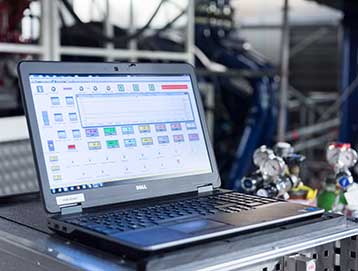How to identify false readings of exhaust monitoring equipment
An increasing number of vessels have encountered unexpected port state issues related to sulphur emissions limit exceedance caused by inaccurate readings. These false measurement readings are often the result of poorly maintained exhaust gas analyzers. This technical news emphasizes the importance of calibration and maintenance routines, and of monitoring equipment performance.
Relevant for ship owners and managers as well as suppliers.

Introduction
Malfunctions of SOx scrubbers or exhaust gas cleaning systems (EGCSs) that last more than one hour should be reported to the flag administration and the relevant port state administration. However, sometimes a malfunction may go undetected because the monitoring equipment does not register any increase in SO2 concentration. Often, the cause of false measurement readings is poor maintenance.
Since crew members are not experts in SO2/CO2 emissions monitoring systems, they may struggle to correctly interpret measurement signals and analyzer readings. The following guidance aims to enhance understanding and build confidence in making the right decisions when faced with suspicious measurement results.
Zero and negative SO2 measurement readings
Zero and negative SO2 readings do not necessarily indicate a failure of the analyzer. Given the allowable calibration accuracy tolerance of +/-2% of the lowest measurement range used, negative readings may still be considered within the acceptable range of the analyzer’s zero setting. Thus, also very low concentrations at in-service measurements may be displayed as zero or even negative.
The following operating conditions typically support high scrubber cleaning efficiencies, resulting in low SO2 levels in the cleaned exhaust gas:
- Low sulphur content of the fuel used
- Low engine load
- High wash water flow rates in the scrubber
Identifying false readings
Despite the above, zero or negative readings are not always plausible measurement results. It is highly recommended to stay alert whenever this is observed. The most effective fault finder is the observer’s experience, which enables a quick assessment of whether the monitored scenario is realistic.
In addition, any of the below observations is a strong indicator for inaccurate zero readings:
- Irritating odour in the exhaust plume, sometimes with eye irritation
- No or very little fluctuations in the measurement readings even after adjusting the wash water flow; measurement readings may drop even further into the negative range after increasing the wash water flow
- CO2 readings below 5%
The use of fuel with a high sulphur content should also result in noticeable SO2 concentrations in the cleaned gas. Usually, the gas analyzers perform regular self-checks which identify system malfunctions or irregularities. However, it is important to frequently check the device’s error messages.
Fault finding
If the analyzer is suspected of showing false readings, follow the manufacturer’s recommended corrective actions to identify any malfunctions.
When performing a leakage check, ensure it covers the entire measuring system, including the sampling probe and sampling line. Ingress air could significantly dilute the sample and reduce SO2 concentrations to very low levels.
Other systematic mistakes could occur during the calibration process. Potential pitfalls range from deviations from the described procedure to the use of calibration gases with component concentrations that differ from pre-settings in the analyzer’s calibration routine. Also, repeated forced zero adjustment during the zero-point setting with low SO2 readings can shift the zero reference over time, reducing measurement sensitivity in the low concentration ranges.
Recorded values may also differ from local display readings if the sensor signal is not aligned with the specified measurement range setting in the control and monitoring system.
The removal of SO2 in the emissions monitoring system may be caused by the cooler. If measures to prevent SO2 losses are not correctly applied, this can result in false lower readings.
Recommendations
- Always be alerted if zero or negative values occur over a longer period, and perform quick plausibility checks.
- Perform a simple validation test: increase the engine load and decrease the wash water flow. If the SO2 measurement signal does not increase, the analyzer likely needs servicing.
- Minimize analyzer malfunctions by strictly following the service, maintenance and calibration intervals and procedures.
References
- MEPC.1, Circ.883, Rev.1: Guidance on indication of ongoing compliance in the case of the failure of a single monitoring instrument, and recommended actions to take if the Exhaust Gas Cleaning System (EGCS) fails to meet the provisions of the EGCS Guidelines
- MEPC.340(77): 2021 Guidelines for Exhaust Gas Cleaning Systems
- NOx Technical Code (2008): Technical Code on Control of Emission of Nitrogen Oxides from Marine Diesel Engines
- DNV Updates to the 2021 guidelines for exhaust gas cleaning systems (“scrubber guideline”)
Contact
- For customers:
DATE - Direct Access to Technical Experts via My Services on Veracity. - Otherwise:
Use our office locator to find the nearest DNV office.
